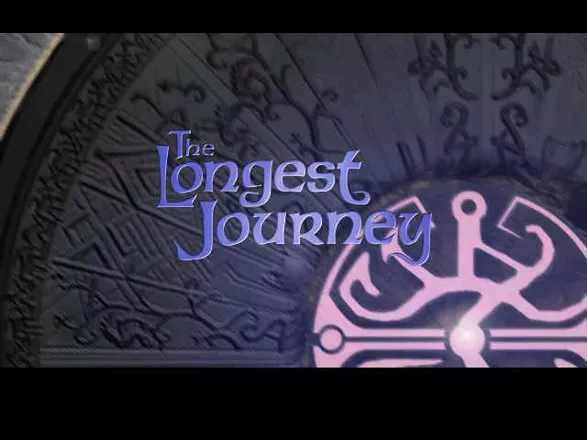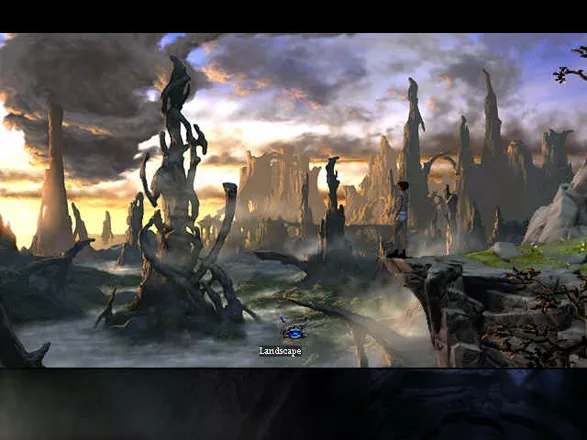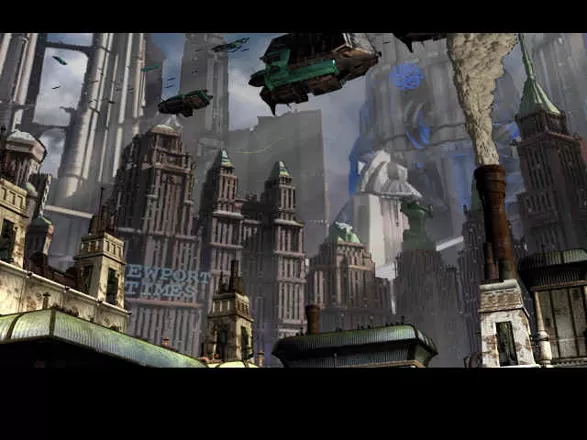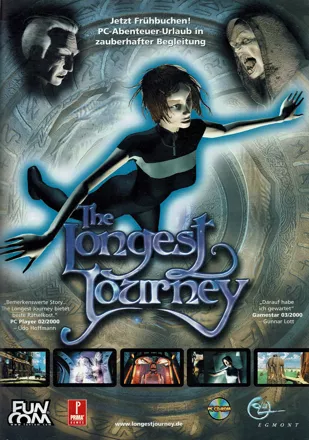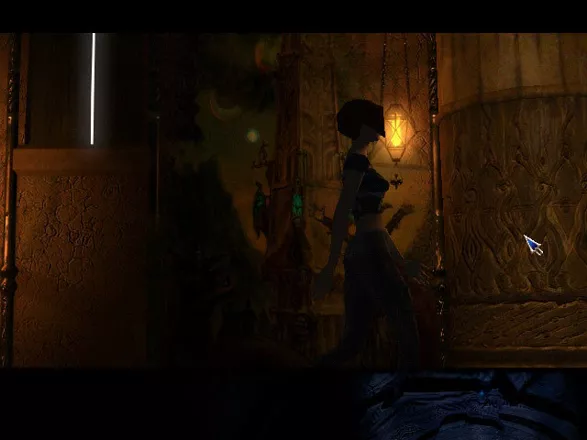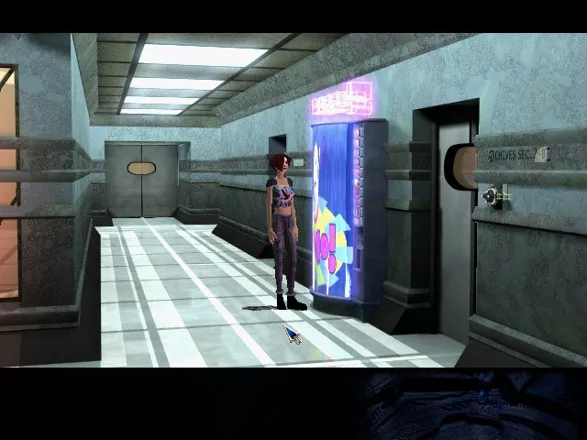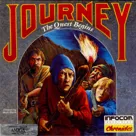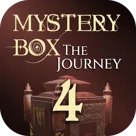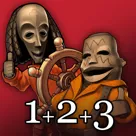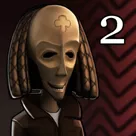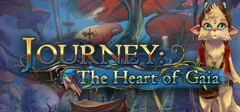The Longest Journey
Description official descriptions
April Ryan is a struggling student artist in the year 2209, recently arrived in the big city of Newport. Lately she has been seeing strange, life-like dreams. Somewhere in the mountains, a mysterious white dragon talks to April, calling her the "mother of the future". When April wakes up, she dismisses the vision as a nightmare. However, an old enigmatic man named Cortez, whom April has spotted near her house before, unexpectedly tells her that she must face the reality in her dreams. Soon April learns that our reality is but one facet of a universe that consists of two parallel worlds: Stark, the world of science and technology, and Arcadia, the world of magic. Though raised in Stark, April possesses the ability of shifting between the two worlds, and must restore the balance in both of them before it is too late.
The Longest Journey is a third-person puzzle-solving adventure game. The player navigates April over pre-rendered backgrounds with fixed camera angles, interacting with people and objects through a simple point-and-click interface. The gameplay follows the traditional template introduced in LucasArts adventures, relying mostly on inventory-based puzzles and multiple-choice dialogues to advance the story. To help keep track of things, the game includes a diary, where April records her thoughts about important events, and a conversation log that records the text of every conversation.
Spellings
- Бесконечное Путешествие - Russian spelling
- 無盡的旅程 - Traditional Chinese spelling
Groups +
Screenshots
Promos
Credits (Windows version)
199 People (193 developers, 6 thanks) · View all
| Producer | |
| Lead Designers | |
| Written By | |
| Art Director | |
| Lead Programmer | |
| Programmers | |
| Installer and Launcher | |
| 3D Studio Max Plug-Ins | |
| Translation Tool | |
| Randy | |
| [ full credits ] | |
Reviews
Critics
Average score: 88% (based on 52 ratings)
Players
Average score: 4.2 out of 5 (based on 212 ratings with 17 reviews)
Somewhat long and boring, but a fun game nonetheless.
The Good
Adventure game fans rejoice! The genre isn't dead!
The Longest Journey certain is the "longest" journey I've played. badum-chink! Ahem.
The game is played through a point-and-click method with a pre-rendered background. Similar to Grim Fandango, in many ways, as well as a number of other adventure games dating back to Sierra's golden age in the early 90s, there's nothing so new to the interface that will leave anyone confused.
The graphics are beautiful, especially the pre-rendered backgrounds. There is amazing scenery throughout the game, from the beautiful areas in the near-future Venice to the colorful island with the snoring giant, to outer space, every part of the game you visit is eye candy. The character models aren't that bad, either.
The story I didn't care for - I'll explain why in the "bad" part - but the setting of the human world I love. It's a solid setting. It's in the near-future, with flying cars and other cliche'd sci-fi elements, but it's not so overly done to the point where it's not at all believable.
You'll fall in love with the characters in this game. My favorite part about the "adventure" game genre is that it's less of a game and more of an interactive movie. The characters in this game are all great, with great voice-acting and unique personalities. April, the talking crow, the sailor, the guy at the cafe, each character, those that had a large part and those that didn't, have a place in the story and I'll miss'em.
The game is four discs long, and it is a loooooong journey. Depending how much you like the game, you'll be spending a long time with it. The puzzles are pretty hard, and can take some work to solve.
The game is filled with lots of humor, and after you beat it you can access outtakes and other extras. THAT is a great thing, and more games should do that.
The Bad
Allright, the story is just dumb. The premise of the story - girl dreams of a world, finds out the world is real, goes and saves the universe - has been done before, but it's still a nice idea. Unfortunately, like far too many games of every genre, you can't progress anywhere in the story until you finish running errands for EVERYBODY. It's not the case in every part of the game. In fact, most of the things you do in the game have to do with the story - like placing the monkey in the garbage to fool the guard so you can sneak into the building or something - but there are way too many times when you have to get help from a certain character, but they won't help you until you do them a favor, which leads to another, and another, and another, and another until you've almost forgotten why you needed the guy's help in the first place.
Some of the puzzles aren't very practical at all. Also like most adventure games, every puzzle has but one sollution and there's no other way around it. It's up to you to solve the puzzle, but you can't do it in a practical way. Like, say, you have to fix a broken electrical wire in the subway. Call a technician? No, you have to use a rubber duck (this is actually a part of the game, though I can't remember exactly how it went about). How do you get the rubber duck? You throw gum out the window...maybe in the end, the idea works (use the rubber to ground the electricity or something), but who would ever think to do the things that get it done in the first place?!
At one point of the game, you have to hear a bunch of stories. Allright, now I'm fine with playing a long game that has a lot of different stories to be told, but I'm not up for sitting down and waiting for an hour while a bunch of bird-people tell me about their history. It's a vital part of the story to hear these stories, too.
The entire story of the game, while executed poorly, was good enough to get you by until the very end. Toward the end, the story just went "kaplooey" and left me pretty damned confused.
April is too ditsy to really be taken seriously. Ever. I wouldn't trust her to take care of my cat, let alone two universes.
The FMV cinematics are awful. The in-game characters looked more realistic than April did. In the cinematics, she looks like she has two black eyes and just got beat up. The animation doesn't seem as good as the in-game animation, either, which is pretty dumb. The FMV is there for dramatic effect, but with a little less effect and better animation, it could have been done in-game and produce the same thing.
There's a race in the game that doesn't live on the same "plane of time". Oh shut up. If it could tell the future, it would have been useful to tell me how I end up solving the damned puzzles.
The Bottom Line
Despite my ranting, as an adventure game it is fun. The story's kind of annoying, but the characters - especially the crow - are great. The graphics are wonderful and you'll spend hours and hours in this game. If you're an adventure fan, get it. If not, save yourself the aggrivation.
Windows · by kbmb (415) · 2002
Great adventure until it reaches the end.
The Good
| Prelude |
Like any other adventure fan, I rushed to get this game after I saw it's potential for releasing interesting vibes and graphical pleasure... although took me a few years longer than I expected. After a full installation of 2+ gigabytes of space and no need for CD-ROM drive, I ran this game to great amazement, I wonder what my face looked like when I saw what I was missing for so long by constantly postponing its getting. It started promising, very promising and very cunning in its own veil of mystery, but it didn't take me too long to realise just how they managed to make a simple wanna-be-epic story out of this game and thus turning the screws into the opposite direction of 'good.'
| And a big + goes to... |
**The Bad**
| And a li'l - goes to... |
**The Bottom Line**
An adventure game that makes a splendid presentation of how you can make a wrong turn even when you're equipped with all the means to create a masterpiece or a classic.
Windows · by MAT (240793) · 2012
Spread your legs!... AND DO THE MONKEYYYYY!!
The Good
(In order to illustrate critical points, this review contains some spoilers for portions of The Longest Journey. You have been warned.)
The Longest Journey is an innovative approach to a genre that desperately needs a breath of fresh air. It's a story about storytelling itself, and more specifically about the very genre of adventure, with a clever device (April's diary) that allows the game to get away with using most of the old adventure cliches (saving the world, collecting a set of jewels, always running errands for everyone), while simultaneously poking good-natured fun at them.
From an audiovisual standpoint, TLJ is a beautiful piece of software. The story is rich, detailed, and LONG, with many conversations spanning as much twenty or thirty minutes. Opinions on this vary, and it will definitely bore players who hate conversation-driven games (not to mention looking at the same screen for any length of time), but I personally felt the extra time and attention to detail in April's world, and the people she knows, created emotional involvement that paid off big-time in the game's second half. The fantasy landscapes are gorgeous to look at, and give something to take in as you're listening to the characters talking. Also, all the conversation delivers a long play time, without forcing players to spend it all solving puzzles and constantly getting stuck.
As an adventure protagonist, April shines. She's extremely easy to like, funny and friendly, and pleasant to listen to (a absolute must since she carries the bulk of the game's dialogue). Not to mention she's a lot more... how I say?... realistically proportioned than, for instance, Lara Croft.
The game is easy to get running, even on older machines. There are no big system-limitation problems, no 64MB AGP accelerators required, and you have the ability to turn off the fancier features and still be able to enjoy the game. (I definitely recommend doing the full 1GB install, though, if you can afford the space.)
The Bad
(LAST CHANCE to avoid the spoilers!)
The rest of the voice acting is good overall, never stiff, but sometimes the game's situations give the canned responses an awkward feel. For instance, when Emily gets shot and April escapes the clutches of the Vanguard, she doesn't know whether her best friend is dead or alive. It should be a very emotional moment, but have April examine her clothes at this point and she points out how, "ARRRRRR, matey!" she looks like a real sailor. Also you still get the "identical voice" effect from having a small cast playing a large number of characters, to the extent that some of them sound very much alike. (Toward the end, with each new character that was introduced, I was able to easily identify the other voices played by the same actor.)
Some of the puzzles and situations are thoroughly contrived, and this doesn't mesh well at all with a story that tries so hard to be original and serious. Take the police station in Stark, for instance: April manages to get into a restricted area because the electronic doors JUST HAPPEN to be broken that day. Then she's able to bypass the retinal scanner because one of the cops on the force JUST HAPPENS to have an artificial eye. Then she's able to get his password because she finds out it's based on his wife's birthday, and she's able to bring up the subject because it JUST HAPPENS to be the very next day. Yrrrrghhh...
The interface itself is occasionally inconsistent. Sometimes you get all the info you need when you examine something the first time, and sometimes it takes you two looks before you see what's really important. To give an item to a character, sometimes you click the item then click it on them, and sometimes you have to talk to the character and choose the line of dialogue that indicates you have the item. In the case of Crow, you click on HIM, then click him on the object you want to use him with. It wouldn't have been so hard to implement multiple methods of achieving the same end. There are also a couple of Myst-ish puzzles, Ancient Mysterious Objects (TM) that must be manipulated in the right way to accomplish something. I've never enjoyed this sort of puzzle, personally.
Inevitably, as with all adventure games, there are points where you run out of options, get stuck, and resort to the "click everything on everything else" method to find the one thing that works that you somehow missed. And this means not understanding the solution until after you've arrived at it. Case in point: I tied the clothesline to the clamp and attached the inflatable duck with no idea why I was doing it, except that the game was letting me. It's only after I noticed the key in the subway that I suddenly had a use for the previously purposeless contraption I'd constructed.
Worst of all, TLJ still suffers from the adventure gaming "broken record": You can talk to characters as many times as you want, and if you've exhausted all conversational possibilities you'll still continue to get the same "Hi"-"Bye" exchange. If you don't get a timing-related puzzle right on the first try, the game makes the event occur over and over until you do. The biggest offenses here are in the case of Officer Minelli dropping and picking up his synthetic eye before you can grab it, and, even worse, "escaping" the Gribbler in the forest. The Gribbler "attacks" April initially, but never chases her beyond that. She can hide behind the table as long as you let her, and the Gribbler never tries to run around and grab her. Once you realize this, any hope of tension is POOF, gone, and the game's urgent music becomes ludicrous. (On the other hand, I do realize that "dying" in an adventure is politically incorrect these days, that people hate "save-and-restore" puzzles. I have yet to see a game that walks this thin line successfully.)
And, once you're completely finished, the game doesn't have much replay value. While the lengthy dialogues weren't hard to sit and listen for me, I currently have no desire to back through any of it, and probably won't for a very long time.
The Bottom Line
Hmm, reading back through the above, it seems to give the impression that I didn't like The Longest Journey. On the contrary, I found it stylish, compelling, and a definite must-play for any adventure fan, though still flawed. Though its story is a solid piece of fiction, I felt it was lacking a few things that would have made a truly great GAME. While certainly the best commercial adventure game in recent years (since Grim Fandango), The Longest Journey still doesn't do much game-wise that's truly innovative, or to revive the fading genre of pure adventure as a whole. But it should give adventure holdouts faith to keep waiting for the next great game (possibly the just-announced sequel), and maybe that one will succeed.
Windows · by Ye Olde Infocomme Shoppe (1674) · 2002
Discussion
| Subject | By | Date |
|---|---|---|
| remake? | hvrsd hvrsd (1) | Jul 11, 2007 |
Trivia
1001 Video Games
The Longest Journey appears in the book 1001 Video Games You Must Play Before You Die by General Editor Tony Mott.
April Ryan
The publisher of The Longest Journey, Egmont Interactive, actually tried to turn April Ryan into a pop icon to match Lara Croft. To that end, they cast a real-life model for April -- 23 years old psychology student Katja Koopmann of Bremen, Germany -- and toured the major magazine and newspaper offices with her, dressed up like April and sputtering lines like “I find April sympathetic” with a somewhat forced smile. Once the PR machine runs, even mediocre game sales can’t stop it. On her way to media star, the virtual April next recorded a song -- a dance remix of the 80’s Depeche Mode tune The Balance -- and Katja lend her voice. Egmont spiced April’s image up with exceptionally stupid PR blurb like “I want everything! Above all, I want to show the people of your world something of the life here!” Generally ignored by the public, the song entered the stores on April 14th ‘00, and stayed there. The corresponding video clip was never played on the music channels, the song didn’t appear in the radio shows, and nobody bought the CD.
Dreamweb
The main character's name is April Ryan, just like Ryan in the game Dreamweb, also published by Empire Interactive Entertainment. And the plots of both games have some things in common (the hero who suffers from nightmares and must save a world he/she didn't even know existed in the first place).
References
- A reference to the Monkey Island series: April's pet toy is called Constable Guybrush. And yes, it's a monkey.
- There are lots of references to sci-fi movies and fantasy themes. Most prominent are the references to Brazil, for instance, which takes place on a red tape-clogged insensitive world much like stark. Take a look at the lobby of the Church of Voltec, it's an exact replica of the Information Retrieval building on Brazil. Also the whole repairmen puzzle where they refuse to work on the grounds that it would require a specific form for them to do so is a spoof of the "Central Services" sequence in the movie. They are even dressed in the same way! There are many more, some more subtle than others.
- Want Star Wars references? check out that strange metal ball on the entrance to The Fringe Café. It says "Death Star" click on it and April will spout famous lines related to it, like "Let's blow this thing and go home!" and she even tries to imitate the voices!
Sales
The Longest Journey was originally made only to be released in Scandinavia, but it then grew with the sales to cover Europe and the U.S. By June of 2001, The Longest Journey had sold 250,000 copies worldwide, 90,000 of which were in America.
Version differences
In order to preserve his foreigner condition, Cortez had his nationality changed from Spanish to French and was renamed "Corthez" in the Spanish version.
Voice acting
- The character Marcus, who only appears in the first chapter near the Fringe cafè, and only has two lines, was voiced by Ragnar Tørnquist, the director/lead designer of the game for the English release.
- In the German pre-release demo version, April was voiced by German pop singer T-Seven known from the, at the time, successful Eurodance group Mr. President. In the final game, April was voiced by Stephanie Kindermann.
Awards
- Computer Gaming World
- April 2000 (Issue #201) - Adventure Game of the Year
- Gamespy
- 2000 - Adventure Game of the Year
- PC Gamer
- 2000 - Adventure Game of the Year
Information also contributed by -Chris, Agent 5, jeremy strope, Karthik KANE, kelmer, Stargazer and Zovni
Analytics
Upgrade to MobyPro to view research rankings!
Related Sites +
-
Hints for The Longest Journey
Adventurers will appreciate these hints. They let you solve the game yourself without spoiling it for you. -
Interview with Ragnar Tornquist
Randy Sluganski talks with Mr. Tornquist about The Longest Journey and its upcoming sequel. -
TLJwiki
A wiki covering the The Longest Journey series. -
The Divide .org - Powered by The Longest Journey Fans
Fansite dedicated to The Longest Journey, an awesome PC adventure game produced by Funcom. Features fan fictions, fan arts, wallpapers, downloads, news, polls, and discussion board. -
Zarf's Review
A review of The Longest Journey by Andrew Plotkin (December, 2002).
Identifiers +
Contribute
Are you familiar with this game? Help document and preserve this entry in video game history! If your contribution is approved, you will earn points and be credited as a contributor.
Contributors to this Entry
Game added by andyhat.
iPad, iPhone added by MrMamen.
Additional contributors: n-n, Robin Lionheart, curacao, Jeanne, JRK, Dec Ryan, Kabushi, Stratege, Zeppin, Laverne, Paulus18950, Patrick Bregger, MrMamen, FatherJack.
Game added May 14, 2000. Last modified March 12, 2024.




